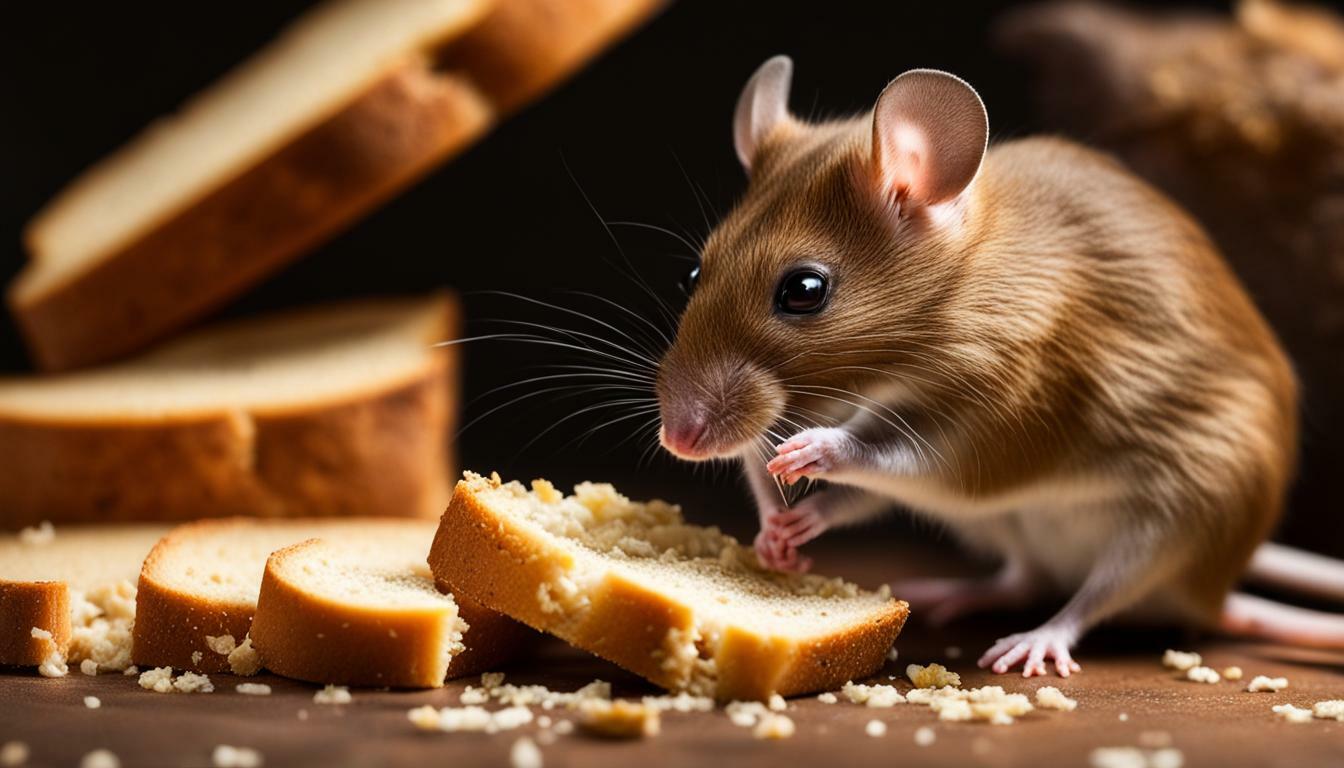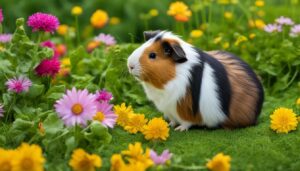Curious about whether mice eat bread? Discover the answer and uncover the dietary preferences of these tiny creatures in this comprehensive guide. Mice are omnivores and will eat a wide variety of foods if offered. They can eat bread, but it should be given in small pieces as they may not be accustomed to the texture. However, bread should not be the main part of their diet and should only be given as an occasional treat. It’s important to supervise mice while they eat bread and watch for signs of distress. Fresh fruits and vegetables, good quality mouse/rat pellets or cubes, and a source of animal protein should be included in their diet. Water should always be available, and fresh food should be removed within 4-6 hours to avoid spoilage. Some foods, such as grapes/raisins, chocolate, avocado, garlic, onion, rhubarb, coffee, tea, alcohol, and walnuts, should not be fed as they are toxic to mice. Lettuce should be avoided as it can cause diarrhea. In addition to a balanced diet, mice should have access to toys and enrichment to prevent boredom.
Key Takeaways:
- Mice can eat bread, but it should be given in moderation as an occasional treat.
- A balanced diet for mice includes fresh fruits, vegetables, mouse/rat pellets, and a source of animal protein.
- Avoid feeding mice toxic foods such as grapes/raisins, chocolate, avocado, garlic, onion, rhubarb, coffee, tea, alcohol, and walnuts.
- Lettuce should be avoided as it can cause diarrhea in mice.
- Provide mice with toys and enrichment to prevent boredom.
What Do Mice Eat?
Mice are omnivores and have a diverse diet. They will eat a wide variety of foods if offered, including fruits, vegetables, grains, seeds, nuts, and even small insects. So, what about bread? Can mice eat bread?
Well, mice can eat bread, but it should be given in small pieces as they may not be accustomed to the texture. However, bread should not be the main part of their diet and should only be given as an occasional treat. It’s important to supervise mice while they eat bread and watch for signs of distress.
When it comes to their regular diet, mice should be provided with fresh fruits and vegetables, good quality mouse/rat pellets or cubes, and a source of animal protein. Water should always be available, and fresh food should be removed within 4-6 hours to avoid spoilage. Some foods should be avoided as they are toxic to mice, such as grapes/raisins, chocolate, avocado, garlic, onion, rhubarb, coffee, tea, alcohol, and walnuts. Lettuce should be avoided as well, as it can cause diarrhea.
In addition to a balanced diet, mice should have access to toys and enrichment to prevent boredom. Keeping these little creatures mentally stimulated is important for their overall well-being.
| Foods that mice can eat: | Foods that mice should avoid: |
|---|---|
|
|
Bread in a Mouse’s Diet
While mice can eat bread, it should only be given in small pieces as an occasional treat due to certain considerations. Mice are omnivores, meaning they eat both plant and animal matter. However, their diets should consist mainly of fresh fruits and vegetables, good quality mouse/rat pellets or cubes, and a source of animal protein. Bread should not be the main part of their diet as it lacks essential nutrients that mice need to thrive.
When offering bread to mice, it’s important to supervise them while they eat and watch for any signs of distress. Some mice may not be accustomed to the texture of bread and may have difficulty chewing and digesting it. To prevent any choking hazards or digestive issues, bread should be given in small, bite-sized pieces.
In addition to bread, there are certain foods that are toxic to mice and should not be fed to them. These include grapes/raisins, chocolate, avocado, garlic, onion, rhubarb, coffee, tea, alcohol, and walnuts. Lettuce should also be avoided as it can cause diarrhea in mice. It’s crucial to provide a balanced diet that meets their nutritional needs.
Table: Foods Suitable for a Mouse’s Diet
| Food | Notes |
|---|---|
| Fresh fruits and vegetables | Should be included in moderation |
| Good quality mouse/rat pellets or cubes | Ensure they contain essential nutrients |
| Source of animal protein | E.g., cooked chicken, mealworms |
| Water | Should always be available |
Along with a balanced diet, it’s vital to provide mice with toys and enrichment to prevent boredom. Mice are intelligent and active creatures that require mental stimulation and physical activity. By offering them opportunities to explore, climb, and play, you can help keep them happy and healthy.
Essential Nutrients for Mice
Alongside bread, discover the essential nutrients that should be included in a mouse’s diet for optimal health and well-being. Mice require a balanced diet that provides them with the necessary nutrients to thrive. While rodents are known to be omnivores, it is important to ensure that their diet consists of a variety of foods to meet their nutritional needs.
A well-rounded diet for mice should include fresh fruits and vegetables, good quality mouse/rat pellets or cubes, and a source of animal protein. These components provide essential vitamins, minerals, and protein that help support their growth and development. Fresh food should be removed within 4-6 hours to prevent spoilage, and water should always be available to keep them hydrated.
| Food | Benefits |
|---|---|
| Fresh fruits and vegetables | Provide essential vitamins and minerals |
| Good quality mouse/rat pellets or cubes | Offer balanced nutrition |
| Source of animal protein | Support growth and development |
It is important to note that certain foods should be avoided as they can be toxic to mice. Grapes/raisins, chocolate, avocado, garlic, onion, rhubarb, coffee, tea, alcohol, and walnuts are among the foods that should not be fed to mice. Lettuce should be avoided as it can cause diarrhea.
In addition to a balanced diet, it is vital to provide mice with toys and enrichment to prevent boredom. Mice are intelligent creatures that require stimulation and mental engagement. By offering toys, tunnels, and other forms of enrichment, you can help keep your mice active and prevent behavioral issues caused by boredom.
Key Takeaways:
- Mice are omnivores and require a balanced diet.
- Include fresh fruits and vegetables, good quality mouse/rat pellets or cubes, and a source of animal protein in their diet.
- Avoid toxic foods such as grapes/raisins, chocolate, avocado, garlic, onion, rhubarb, coffee, tea, alcohol, and walnuts.
- Do not feed lettuce to mice as it can cause diarrhea.
- Provide mice with toys and enrichment to prevent boredom and promote mental stimulation.
By understanding the essential nutrients and dietary requirements of mice, you can ensure their overall well-being and contribute to their long and healthy lives.
| Additional Resources: |
|---|
| 1. Mouse Diet Guide: Proper Nutrition for Pet Mice |
| 2. Interactive Toys for Pet Mice: Keeping Them Active and Happy |
Enrichment and Boredom Prevention
In addition to a nutritious diet, find out why it’s crucial to offer mice toys and environmental enrichment to ensure their overall happiness.
Mice are curious and active creatures that require mental and physical stimulation to thrive. Providing them with toys and environmental enrichment not only prevents boredom but also promotes their well-being. A lack of enrichment can lead to stress, lethargy, and even behavioral issues. By creating a stimulating environment, you can help keep your mice happy and engaged.
One way to provide enrichment is by offering a variety of toys and activities. Mice enjoy climbing, exploring, and burrowing, so providing them with tunnels, ropes, and ladders can satisfy their natural instincts. You can also offer them chew toys to keep their teeth healthy and provide opportunities for foraging by hiding treats or food in interactive puzzles.
Another important aspect of enrichment is the mouse’s living space. A spacious and well-designed cage or enclosure can offer plenty of opportunities for exploration. Adding branches, perches, and hiding spots can create a more natural and stimulating environment. It’s also important to regularly rotate and change the toys and accessories in the cage to keep things fresh and exciting for the mice.
| Enrichment Tips for Mice: |
|---|
| Provide a variety of toys for climbing, exploring, and burrowing. |
| Offer chew toys to keep their teeth healthy. |
| Create opportunities for foraging by hiding treats or food in interactive puzzles. |
| Design a spacious and well-equipped living space with branches, perches, and hiding spots. |
| Regularly rotate and change toys and accessories in the cage. |
Remember to always monitor your mice while they play with toys or interact with their environment. Ensure that the toys are safe and free from small parts that could be swallowed or cause injury. Regularly clean and sanitize the cage and toys to maintain a hygienic environment for your mice. By providing enrichment and preventing boredom, you can contribute to the overall health and happiness of your mice.
Conclusion
By understanding the dietary habits of mice, including their relationship with bread, you can ensure their nutritional needs are met while also keeping them entertained and healthy.
Mice are omnivores and have a wide variety of foods in their diet. While they can eat bread, it should only be given in small pieces as they may not be accustomed to the texture. However, bread should not be the main part of their diet and should only be given as an occasional treat.
It’s important to supervise mice while they eat bread and watch for signs of distress. Fresh fruits and vegetables, good quality mouse/rat pellets or cubes, and a source of animal protein should be included in their diet. Water should always be available, and fresh food should be removed within 4-6 hours to avoid spoilage.
There are certain foods that should not be fed to mice as they are toxic, including grapes/raisins, chocolate, avocado, garlic, onion, rhubarb, coffee, tea, alcohol, and walnuts. Lettuce should also be avoided as it can cause diarrhea. In addition to providing a balanced diet, it’s essential to give mice access to toys and enrichment to prevent boredom.
FAQ
Do mice eat bread?
Yes, mice can eat bread. However, it should be given in small pieces as they may not be accustomed to the texture. Bread should not be the main part of their diet and should only be given as an occasional treat.
What do mice eat?
Mice are omnivores and will eat a wide variety of foods if offered. Their diet should include fresh fruits and vegetables, good quality mouse/rat pellets or cubes, and a source of animal protein. Water should always be available.
Is bread included in a mouse’s diet?
While mice can eat bread, it should be included in moderation. It should not be the main part of their diet and should only be given as an occasional treat. Watch for signs of distress while mice eat bread and supervise their consumption.
What are the essential nutrients for mice?
Mice require a balanced diet that includes fresh fruits and vegetables, good quality mouse/rat pellets or cubes, and a source of animal protein. These provide the essential nutrients needed for their well-being.
How can I prevent boredom in mice?
It’s important to provide mice with toys and enrichment to prevent boredom. This can include items such as exercise wheels, tunnels, and chew toys. Keeping them mentally stimulated is crucial for their overall health and well-being.




